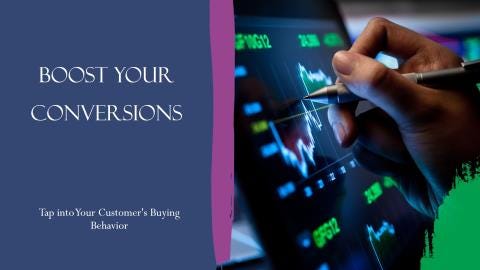How to Boost Conversions by Tapping into Your Customer’s Buying Behavior (/The Power of Understanding Customer Behavior)

“Imagine being able to predict your customer’s next move with such precision that your marketing campaigns hit the bullseye every time. This isn’t just wishful thinking — it’s the reality for brands that have mastered the art of understanding and leveraging customer buying behavior. If you’re ready to move beyond guesswork and start driving real results, then this is the strategy you need to master.”
Importance of Consumer Behavior:

Customer behavior patterns:

The Psychological Drivers of Buying Decisions
Understanding why customers make the decisions they do is key to creating effective marketing strategies. The decision to purchase is influenced by a mix of psychological triggers, emotional needs, and external factors.
- Emotional Triggers:
- Example: Coca-Cola’s “Share a Coke” campaign leveraged personal names on bottles to create an emotional connection, leading to a 2% increase in sales in the U.S.
- Application: Marketers can tap into these emotional triggers by personalizing their messaging and making their campaigns more relatable on an individual level.
2. Social Influence:
- Example: Starbucks’ success is partly due to the brand’s ability to create a social experience around coffee. By fostering a community, they turn a simple purchase into a lifestyle choice.
- Application: Encourage user-generated content and foster a community around your brand to amplify social proof and influence.
3. Perception of Value:
- Example: Apple’s branding creates a perception of premium quality, justifying its higher price points. Customers believe they are getting more value, even if alternatives are technically similar.
- Application: Highlight the unique value propositions of your product to justify pricing and encourage purchase.
“It’s not just about what your product does; it’s about how your product makes them feel.”

From Insight to Action: Turning Behavioral Insights into Conversion Strategies
Once you’ve gained insights into your customer’s behavior, the next step is to turn these insights into actionable strategies that boost conversions.
- Personalization at Scale:
- Example: Amazon’s recommendation engine drives 35% of its total sales by analyzing past behaviors and suggesting relevant products.
- Practical Tip: Implement dynamic content on your website that changes based on user behavior, preferences, and past purchases. Use CRM data to send personalized email campaigns that align with individual customer journeys.
2. Creating Urgency and Scarcity:
- Example: The airline industry effectively uses countdowns and limited seat availability notifications to prompt immediate bookings.
- Practical Tip: Use real-time data to create urgency. For instance, display low-stock warnings or limited-time discounts to encourage quicker purchase decisions.
3. Streamlining the Purchase Journey:
- Example: Shopify stores that offer one-click checkout options have reported up to 30% higher conversion rates compared to traditional multi-step checkouts.
- Practical Tip: Simplify the checkout process by reducing the number of steps and offering guest checkout options to minimize friction.
4. Leveraging Retargeting:
- Example: According to a study by Criteo, website visitors who are retargeted with display ads are 70% more likely to convert.
- Practical Tip: Use retargeting strategies to remind potential customers of products they viewed but didn’t purchase. Offer incentives like discounts or free shipping to bring them back.
“Don’t let your customers walk away — turn those ‘maybes’ into ‘absolutelys’ by keeping the conversation going.”
Data-Driven Marketing: How Analytics Can Supercharge Your Strategy
In the era of big data, understanding your customer’s behavior has never been easier — or more critical. The brands that can analyze and act on this data are the ones that thrive.
- Behavioral Segmentation:
- Example: Netflix uses behavioral data to segment its audience, delivering personalized content that keeps users engaged and subscribed.
Impact on Roles:
- For Data Analysts: Develop sophisticated segmentation models based on customer interactions, purchase history, and engagement levels.
- For Content Marketers: Tailor content strategies to different segments, ensuring that each customer group receives relevant and compelling content.
2. Predictive Analytics:
- Example: Retailers like Walmart use predictive analytics to anticipate stock needs based on consumer buying patterns, ensuring products are available when demand spikes.
Impact on Roles:
- For Marketing Operations: Leverage predictive analytics to forecast trends and plan campaigns around anticipated consumer behaviors.
- For Sales Teams: Use predictions to focus efforts on high-probability leads, optimizing resource allocation and increasing close rates.
3. Real-Time Marketing:
- Example: Spotify’s “Wrapped” campaign uses real-time data to create personalized end-of-year summaries for users, driving engagement and brand loyalty.
Impact on Roles:
- For Social Media Managers: Capitalize on trending topics and real-time data to engage with audiences in the moment, making your brand part of the conversation.
- For CRM Managers: Implement real-time triggers that send personalized offers or messages when a customer exhibits a specific behavior, such as cart abandonment.
“The future of marketing is in the numbers — are you reading them right?”
Practical Applications for Different Marketing Roles
The insights derived from customer behavior can be applied across various marketing functions, making your strategies more effective and your results more impactful.
- For Content Marketers:
- Action: Use customer data to create hyper-relevant content that addresses specific pain points, needs, and desires of different audience segments.
- Example: HubSpot’s personalized blog recommendations drive 30% more traffic from returning visitors by showing them articles based on their previous interactions.
2. For Social Media Managers:
- Action: Leverage behavioral insights to schedule posts when your audience is most active, and tailor your content to match their interests and behaviors.
- Example: Dunkin’ Donuts successfully uses location-based social media campaigns to target users with offers when they are near a store, leading to increased foot traffic and sales.
3. For Email Marketers:
- Action: Use automation tools to send personalized emails triggered by specific customer actions, such as browsing certain categories or abandoning a cart.
- Example: Nike’s automated email campaigns offer personalized product recommendations based on browsing history, resulting in a 10% increase in conversions.
4. For Revenue Operations:
- Action: Ensure alignment between marketing, sales, and customer service by integrating behavioral data across all teams, providing a seamless customer experience.
- Example: Salesforce’s CRM integrates customer data across departments, allowing for a cohesive strategy that drives higher customer satisfaction and retention.
“In today’s data-driven world, the brands that win are the ones that know their customers better than anyone else. Don’t just compete — dominate by understanding what makes your customers tick and turning those insights into action.”

Comments
Post a Comment